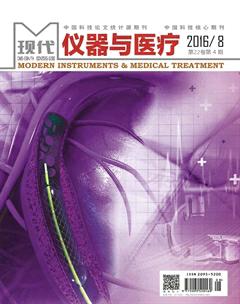肌电图仪评价错牙合畸形患者正颌手术后咀嚼肌功能变化
米磊 刘怀勤 高宇



[摘 要] 目的:运用肌电图仪评价错牙合畸形患者正颌手术后咀嚼肌功能变化,了解患者术后咀嚼肌功能的变化规律。方法:选取我院2013年8月—2015年8月收治的31例接受正颌手术的错牙合畸形患者纳入观察组,并选取同期30名正常牙合者纳入对照组。运用肌电图仪检测静息放松时、左右侧方最大运动各咀嚼肌肌电位,以及正中紧咬时、最大开口、正中前伸、咀嚼运动时咀嚼肌肌电位及不对称指数,并分析观察组患者术后咀嚼肌功能变化。结果:除静息放松外,观察组术前咀嚼肌肌电位低于对照组,且以紧咬、咀嚼时差异最为明显(P<0.05);术后3个月时,观察组患者部分咀嚼肌功能有所恢复,但紧咬、咀嚼时肌电位仍显著低于对照组,差异有统计学意义(P<0.05);术后6个月时,患者咀嚼肌功能较术前、术后3个月改善明显差异有统计学意义(P<0.05)。结论:错牙合畸形患者正颌手术后咬合及肌肉功能均逐渐增强,但功能未达正常水平。
[关键词] 肌电图仪;错牙合畸形;正颌手术;咀嚼肌功能
中图分类号:R 783.5 文献标识码:B 文章编号:2095-5200(2016)04-019-04
DOI:10.11876/mimt201604008
Application of electromyogram in evaluation of change of masticatory muscle function in malocclusal patients after orthognathic surgery MI Lei,LIU Huaiqin,GAO Yu. (Department of stomatology,The First Hospital of Yulin,Yulin 719000,China)
[Abstract] Objective: To evaluate the use of electromyogram in evaluation of change of masticatory muscle function in malocclusal patients after orthognathic surgery, for understanding of changes of postoperative masticatory muscle function. Methods: 31 patients with malocclusion undergoing orthognathic surgery in our hospital from August 2013 to August 2015 were included in the observation group, and 30 healthy people with normal occlusion were included in the control group. The electromyogram data was detected during rest position, centric clenching, mouth opening, protrusive movement, laterotrusive movement, potentials of the masticatory muscles when chewing and the asymmetric index of masticatory muscle, were used to analyze the masticatory muscle function in malocclusal patients after orthognathic surgery. Results: Except resting relaxation, potentials of masticatory muscles of observation group surgery is lower than that of the control group, and differences were statistically significant when clenching and chewing (P<0.05); 3 months after surgery, some masticatory muscle functions of patients in the observation group have been restored, but potentials of masticatory muscles were still significantly lower than those of the control group when clenching and chewing, the differences were statistically significant (P<0.05); at 6 months, masticatory muscle function of patients improved significantly compared with those of pre-operation and post-operative 3 months, the differences were statistically significant (P<0.05). Conclusions: Occlusion and muscle function of malocclusal patients after orthognathic surgery were gradually increased, but the function is less than the normal level.
[Key words] electromyogram;malocclusion;orthognathic surgery;masticatory muscle function
目前临床常见的错牙合畸形以骨性Ⅲ类畸形为主 [1]。正颌手术改善上下颌骨关系,恢复正常咬合关系[2]。通过肌电图测定咀嚼肌功能是评价正颌手术治疗效果的常用方案,但咀嚼肌功能变化是否会对咬合功能产生影响、会产生何种影响,目前临床尚无定论[3]。为分析咀嚼肌功能变化,本文选取31例错牙合畸形患者及30名正常牙合者进行了前瞻性对照研究,现将研究方法与结果总结如下。
1 资料与方法
1.1 一般资料
选取我院2013年8月—2015年8月收治的31例接受正颌手术的错牙合畸形患者纳入观察组,31例患者均为骨性Ⅲ类错牙合畸形,其中28例已接受术前正畸治疗,3例直接行正颌手术治疗。并选取同期30名正常牙合者,纳入对照组,30名正常者面部对称度良好,均未见畸形,开口度、开口型正常,颞下颌关节无疼痛或弹响,牙列完整且排列整齐,排除近1年内有拔牙史、牙体病史、牙周炎史、口腔黏膜病史、正畸治疗史、面部肌病、神经病史者[4]。两组性别、年龄等一般资料比较,差异无统计学意义(P>0.05),具有可比性。本临床研究经我院医学伦理委员会批准,受试者均知情同意并签署知情同意书。
1.2 检测方法
检测设备为M153635-Medelec Synergy二通道肌电图诱发电位仪(英国Oxford公司),检测方法:以75%乙醇消毒皮肤,嘱受试者取息止颌位,即头颈部放松端坐,自然分开上下牙,休息3~5 min后咬紧双侧后牙,安置电极,定位解剖标志,将电极膏涂于电极盘表面,使用胶布固定,记录静息放松、正中紧咬、最大开口、正中前伸、左右侧方最大运动、咀嚼运动时肌电数据(对照组于入组时测定,观察组于正颌手术前、术后3个月、术后6个月各测定1次)[5]。
1.3 评价指标及统计
肌电图仪评价指标包括静息放松时、左右侧方最大运动各咀嚼肌肌电位,以及正中紧咬时、最大开口、正中前伸、咀嚼运动时咀嚼肌肌电位及不对称指数,不对称指数=(左侧肌电位-右侧肌电位)/(左侧肌电位+右侧肌电位)×100%,取绝对值[6-7]。对本临床研究的所有数据采用SPSS18.0进行分析,以P<0.05为有统计学意义。
2 结果
2.1 咀嚼肌肌电位
正颌手术前:静息放松、前伸运动时,观察组各咀嚼肌肌电位与对照组比较,差异无统计学意义(P>0.05);正中紧咬、咀嚼运动时,其咀嚼肌肌电位显著低于对照组,差异有统计学意义(P<0.05);开口运动时,其两侧颞肌前束、右侧咬肌、左侧二腹肌肌电位显著低于对照组,差异有统计学意义(P<0.05);侧方运动时,其两侧肌电位均显著低于对照组,差异有统计学意义(P<0.05)。
术后3个月:正中紧咬时,观察组咀嚼肌肌电位显著低于对照组,且肌不对称指数显著高于后者,差异有统计学意义(P<0.05);开口运动时,观察组仅右侧颞肌肌电位显著低于对照组,差异有统计学意义(P<0.05);前伸运动时,其左侧二腹肌肌电位仍显著低于对照组,差异有统计学意义(P<0.05);侧方运动时,观察组咀嚼肌肌电位与正颌手术前比较差异无统计学意义(P>0.05);咀嚼运动时,观察组颞肌、咬肌肌电位显著低于对照组,差异有统计学意义(P<0.05)。
术后6个月:正中紧咬时,观察组咀嚼肌肌电位显著高于正颌手术前、术后3个月,但仍低于对照组水平,差异有统计学意义(P<0.05);开口运动、前伸运动时,多数咀嚼肌肌电位有所恢复,且与对照组比较,差异无统计学意义(P>0.05);咀嚼运动时,咀嚼肌肌电位明显改善,除右侧二腹肌外,其他咀嚼肌肌电位与对照组比较差异无统计学意义(P>0.05)。
详细数据见表1、表2、表3。
3 讨论
正颌手术是恢复错牙合畸形患者口颌系统形态与功能协调的首选方案,但由于正颌手术使颅面骨骼结构、肌肉附着关系发生突然改变,此时患者口颌系统咀嚼肌往往无法迅速适应该变化,功能重建过程可能受到一定影响[9]。自上世纪40年代起即有学者将肌电图仪用于口腔医学领域,作为一种客观、定量反映肌肉神经系统技能状态的设备,肌电图仪为口颌系统形态与功能关系的研究、治疗效果评价提供了便利、准确的手段[10]。 本研究结果显示观察组患者术前咀嚼肌肌电图表现与对照组差异明显,主要表现在下颌运动的正中紧咬、开口及咀嚼运动时,与过往研究一致[11-12],其原因考虑为:1)错牙合畸形患者下颌体往往较长,这一解剖构造可导致下颌运动时咀嚼肌阻力臂增长,机械效能受到影响[13];
2)该类患者上下牙列协调性有限、咬合关系不理想,牙合接触面积处于异常状态,故紧咬、咀嚼运动时承受牙合力的牙位数偏少,受力牙周组织无法承受负荷时即可导致咀嚼肌收缩力反射性降低[14];3)多数患者后牙处于反牙合状态且伴有尖窝关系异常,左侧、右侧运动时牙合受到明显干扰,下颌运动受限;4)部分患者接受正畸治疗,该治疗方案对患者咀嚼肌功能亦存在一定影响,故患者咀嚼肌功能不及正常牙合者。
Ko等[15]认为咀嚼肌在颌骨的生长发育中扮演着重要角色。正颌手术后咀嚼肌在各类下颌运动中机械效率、协调性均有所提升[16],本研究患者术后3个月咀嚼肌肌电位较术前状态有了一定程度的改善,但其咀嚼肌肌电位尚未恢复正常水平,主要由于术后短期内疼痛、麻木等感觉异常诱发肌肉收缩力量反射性减弱。此外,Takeshita等[17]指出,咀嚼肌对新牙合位置尚不适应、牙尖窝关系尚不精确亦可能是导致紧咬、咀嚼运动时咀嚼肌肌电位不理想的原因之一。
本研究观察组术后6个月咀嚼肌肌电位得到了进一步改善,但仍未达到正常水平,因此,在强调正颌手术的同时,应注重术后功能锻炼,促进口颌系统功能的整体恢复与完善。
参 考 文 献
[1] Kumar S, Tripathi T, Sidhu M S, et al. Skeletal Class II correction and neuromuscular adaptation with twin-block: A cephalometric and electromyography study in adults[J]. J Indian Orthod Soc, 2016, 50(2): 94.
[2] Sandhu S S, Utreja A, Prabhakar S, et al. A Study of Electromyographic Activity of Masseter and Temporalis Muscles and Maximum Bite Force in Patients with Various Malocclusions[J]. J Indian Orthod Soc, 2013, 47(2): 53.
[3] 何媛, 张琪, 李天舒, 等. 不同牙合型人群咀嚼肌肌电活动的研究[J]. 口腔医学研究, 2015, 31(11): 1143-1147.
[4] Ciavarella D, Monsurrò A, Padricelli G, et al. Unilateral posterior crossbite in adolescents: surface electromyographic evaluation[J]. Eur J Paediatr Dent, 2012, 13(1): 25.
[5] 曹盟. 稳定性咬合板治疗颞下颌关节紊乱病的咀嚼肌肌电图研究[D]. 济南:山东大学, 2008.
[6] 谢贤聚, 白玉兴, 幸丹, 等. 骨性 Ⅲ 类错牙合畸形患者正颌术后咀嚼肌功能及牙合力的研究[J]. 北京口腔医学, 2014, 22(3): 147-150.
[7] Nakamura A, Zeredo J L, Utsumi D, et al. Influence of malocclusion on the development of masticatory function and mandibular growth[J]. Angle Orthod, 2013, 83(5): 749-757.
[8] Satygo E A, Silin A V, Ramirez-Ya?ez G O. Electromyographic Muscular Activity Improvement in Class II Patients Treated with the Pre-Orthodontic Trainer[J]. J Clin Pediatr Dent, 2014, 38(4): 380-384.
[9] 蔡鸣, 沈国芳, 房兵, 等. Moebius 综合征患者牙颌面特征及正颌正畸治疗远期疗效评价[J]. 中国口腔颌面外科杂志, 2012, 10(1): 29-37.
[10] Uysal T, Yagci A, Kara S, et al. Influence of Pre-Orthodontic Trainer treatment on the perioral and masticatory muscles in patients with Class II division 1 malocclusion[J]. Eur J Orthod, 2012, 34(1): 96-101.
[11] Ikenaga N, Yamaguchi K, Daimon S. Effect of mouth breathing on masticatory muscle activity during chewing food[J]. J Oral Rehabil, 2013, 40(6): 429-435.
[12] Petrovi? ?, Vujkov S, Petronijevi? B, et al. Examination of the bioelectrical activity of the masticatory muscles during Angles Class II division 2 therapy with an activator[J]. Vojnosanit Pregl, 2014, 71(12): 1116-1122.
[13] Saccomanno S, Antonini G, DAlatri L, et al. Causal relationship between malocclusion and oral muscles dysfunction: a model of approach[J]. Eur J Paediatr Dent, 2012, 13(4): 321-323.
[14] Raman P. Physiologic neuromuscular dental paradigm for the diagnosis and treatment of temporomandibular disorders[J]. J Calif Dent Assoc, 2014, 42(8): 563-571.
[15] Ko E W C, Huang C S, Lo L J, et al. Alteration of masticatory electromyographic activity and stability of orthognathic surgery in patients with skeletal class III malocclusion[J]. Int J Oral Maxillofac Surg, 2013, 71(7): 1249-1260.
[16] Monaco A, Sgolastra F, Petrucci A, et al. Prevalence of vision problems in a hospital-based pediatric population with malocclusion[J]. Pediatr Dent, 2013, 35(3): 272-274.
[17] Takeshita N, Ishida M, Watanabe H, et al. Improvement of asymmetric stomatognathic functions, unilateral crossbite, and facial esthetics in a patient with skeletal Class III malocclusion and mandibular asymmetry, treated with orthognathic surgery[J]. Am J Orthod Dentofac, 2013, 144(3): 441-454.

